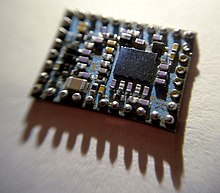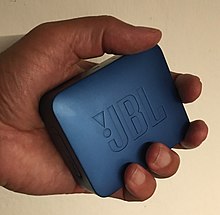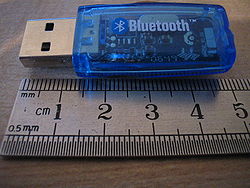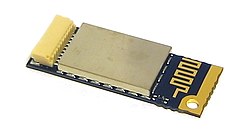
A | B | C | D | E | F | G | H | CH | I | J | K | L | M | N | O | P | Q | R | S | T | U | V | W | X | Y | Z | 0 | 1 | 2 | 3 | 4 | 5 | 6 | 7 | 8 | 9
 | |
| Developed by | Bluetooth Special Interest Group |
|---|---|
| Introduced | 7 May 1998 |
| Industry | Personal area networks |
| Compatible hardware | |
| Physical range | Typically less than 10 m (33 ft), up to 100 m (330 ft). Bluetooth 5.0: 40–400 m (100–1,000 ft)[1][2] |
| Website | www |

Bluetooth is a short-range wireless technology standard that is used for exchanging data between fixed and mobile devices over short distances and building personal area networks (PANs). In the most widely used mode, transmission power is limited to 2.5 milliwatts, giving it a very short range of up to 10 metres (33 ft). It employs UHF radio waves in the ISM bands, from 2.402 GHz to 2.48 GHz.[3] It is mainly used as an alternative to wired connections to exchange files between nearby portable devices and connect cell phones and music players with wireless headphones.
Bluetooth is managed by the Bluetooth Special Interest Group (SIG), which has more than 35,000 member companies in the areas of telecommunication, computing, networking, and consumer electronics. The IEEE standardized Bluetooth as IEEE 802.15.1 but no longer maintains the standard. The Bluetooth SIG oversees the development of the specification, manages the qualification program, and protects the trademarks.[4] A manufacturer must meet Bluetooth SIG standards to market it as a Bluetooth device.[5] A network of patents applies to the technology, which is licensed to individual qualifying devices. As of 2021[update], 4.7 billion Bluetooth integrated circuit chips are shipped annually.[6]
Etymology
The name "Bluetooth" was proposed in 1997 by Jim Kardach of Intel, one of the founders of the Bluetooth SIG. The name was inspired by a conversation with Sven Mattisson who related Scandinavian history through tales from Frans G. Bengtsson's The Long Ships, a historical novel about Vikings and the 10th-century Danish king Harald Bluetooth. Upon discovering a picture of the runestone of Harald Bluetooth[7] in the book A History of the Vikings by Gwyn Jones, Kardach proposed Bluetooth as the codename for the short-range wireless program which is now called Bluetooth.[8][9][10]
According to Bluetooth's official website,
Bluetooth was only intended as a placeholder until marketing could come up with something really cool.
Later, when it came time to select a serious name, Bluetooth was to be replaced with either RadioWire or PAN (Personal Area Networking). PAN was the front runner, but an exhaustive search discovered it already had tens of thousands of hits throughout the internet.
A full trademark search on RadioWire couldn't be completed in time for launch, making Bluetooth the only choice. The name caught on fast and before it could be changed, it spread throughout the industry, becoming synonymous with short-range wireless technology.[11]
Bluetooth is the Anglicised version of the Scandinavian Blåtand/Blåtann (or in Old Norse blátǫnn). It was the epithet of King Harald Bluetooth, who united the disparate Danish tribes into a single kingdom; Kardach chose the name to imply that Bluetooth similarly unites communication protocols.[12]
The Bluetooth logo ![]() is a bind rune merging the Younger Futhark runes
is a bind rune merging the Younger Futhark runes ![]() (ᚼ, Hagall) and
(ᚼ, Hagall) and ![]() (ᛒ, Bjarkan), Harald's initials.[13][14]
(ᛒ, Bjarkan), Harald's initials.[13][14]
History

This article needs additional citations for verification. (February 2024) |
The development of the "short-link" radio technology, later named Bluetooth, was initiated in 1989 by Nils Rydbeck, CTO at Ericsson Mobile in Lund, Sweden. The purpose was to develop wireless headsets, according to two inventions by Johan Ullman, SE 8902098-6, issued 1989-06-12 and SE 9202239, issued 1992-07-24. Nils Rydbeck tasked Tord Wingren with specifying and Dutchman Jaap Haartsen and Sven Mattisson with developing.[15] Both were working for Ericsson in Lund.[16] Principal design and development began in 1994 and by 1997 the team had a workable solution.[17] From 1997 Örjan Johansson became the project leader and propelled the technology and standardization.[18][19][20][21]
In 1997, Adalio Sanchez, then head of IBM ThinkPad product R&D, approached Nils Rydbeck about collaborating on integrating a mobile phone into a ThinkPad notebook. The two assigned engineers from Ericsson and IBM studied the idea. The conclusion was that power consumption on cellphone technology at that time was too high to allow viable integration into a notebook and still achieve adequate battery life. Instead, the two companies agreed to integrate Ericsson's short-link technology on both a ThinkPad notebook and an Ericsson phone to accomplish the goal.
Since neither IBM ThinkPad notebooks nor Ericsson phones were the market share leaders in their respective markets at that time, Adalio Sanchez and Nils Rydbeck agreed to make the short-link technology an open industry standard to permit each player maximum market access. Ericsson contributed the short-link radio technology, and IBM contributed patents around the logical layer. Adalio Sanchez of IBM then recruited Stephen Nachtsheim of Intel to join and then Intel also recruited Toshiba and Nokia. In May 1998, the Bluetooth SIG was launched with IBM and Ericsson as the founding signatories and a total of five members: Ericsson, Intel, Nokia, Toshiba, and IBM.
The first Bluetooth device was revealed in 1999. It was a hands-free mobile headset that earned the "Best of show Technology Award" at COMDEX. The first Bluetooth mobile phone was the Ericsson T36, but it was the revised Ericsson model T39 that actually made it to store shelves in 2001. In parallel, IBM introduced the IBM ThinkPad A30 in October 2001 which was the first notebook with integrated Bluetooth.
Bluetooth's early incorporation into consumer electronics products continued at Vosi Technologies in Costa Mesa, California, initially overseen by founding members Bejan Amini and Tom Davidson. Vosi Technologies had been created by real estate developer Ivano Stegmenga, with United States Patent 608507, for communication between a cellular phone and a vehicle's audio system. At the time, Sony/Ericsson had only a minor market share in the cellular phone market, which was dominated in the US by Nokia and Motorola. Due to ongoing negotiations for an intended licensing agreement with Motorola beginning in the late 1990s, Vosi could not publicly disclose the intention, integration, and initial development of other enabled devices which were to be the first "Smart Home" internet connected devices.
Vosi needed a means for the system to communicate without a wired connection from the vehicle to the other devices in the network. Bluetooth was chosen, since Wi-Fi was not yet readily available or supported in the public market. Vosi had begun to develop the Vosi Cello integrated vehicular system and some other internet connected devices, one of which was intended to be a table-top device named the Vosi Symphony, networked with Bluetooth. Through the negotiations with Motorola, Vosi introduced and disclosed its intent to integrate Bluetooth in its devices. In the early 2000s a legal battle[22] ensued between Vosi and Motorola, which indefinitely suspended release of the devices. Later, Motorola implemented it in their devices which initiated the significant propagation of Bluetooth in the public market due to its large market share at the time.
In 2012, Jaap Haartsen was nominated by the European Patent Office for the European Inventor Award.[17]
Implementation
Bluetooth operates at frequencies between 2.402 and 2.480 GHz, or 2.400 and 2.4835 GHz, including guard bands 2 MHz wide at the bottom end and 3.5 MHz wide at the top.[23] This is in the globally unlicensed (but not unregulated) industrial, scientific and medical (ISM) 2.4 GHz short-range radio frequency band. Bluetooth uses a radio technology called frequency-hopping spread spectrum. Bluetooth divides transmitted data into packets, and transmits each packet on one of 79 designated Bluetooth channels. Each channel has a bandwidth of 1 MHz. It usually performs 1600 hops per second, with adaptive frequency-hopping (AFH) enabled.[23] Bluetooth Low Energy uses 2 MHz spacing, which accommodates 40 channels.[24]
Originally, Gaussian frequency-shift keying (GFSK) modulation was the only modulation scheme available. Since the introduction of Bluetooth 2.0+EDR, π/4-DQPSK (differential quadrature phase-shift keying) and 8-DPSK modulation may also be used between compatible devices. Devices functioning with GFSK are said to be operating in basic rate (BR) mode, where an instantaneous bit rate of 1 Mbit/s is possible. The term Enhanced Data Rate (EDR) is used to describe π/4-DPSK (EDR2) and 8-DPSK (EDR3) schemes, transferring 2 and 3 Mbit/s respectively.
In 2019, Apple published an extension called HDR which supports data rates of 4 (HDR4) and 8 (HDR8) Mbit/s using π/4-DQPSK modulation on 4 MHz channels with forward error correction (FEC).[25]
Bluetooth is a packet-based protocol with a master/slave architecture. One master may communicate with up to seven slaves in a piconet. All devices within a given piconet use the clock provided by the master as the base for packet exchange. The master clock ticks with a period of 312.5 μs, two clock ticks then make up a slot of 625 μs, and two slots make up a slot pair of 1250 μs. In the simple case of single-slot packets, the master transmits in even slots and receives in odd slots. The slave, conversely, receives in even slots and transmits in odd slots. Packets may be 1, 3, or 5 slots long, but in all cases, the master's transmission begins in even slots and the slave's in odd slots.
The above excludes Bluetooth Low Energy, introduced in the 4.0 specification,[26] which uses the same spectrum but somewhat differently.
Communication and connection
A master BR/EDR Bluetooth device can communicate with a maximum of seven devices in a piconet (an ad hoc computer network using Bluetooth technology), though not all devices reach this maximum. The devices can switch roles, by agreement, and the slave can become the master (for example, a headset initiating a connection to a phone necessarily begins as master—as an initiator of the connection—but may subsequently operate as the slave).
The Bluetooth Core Specification provides for the connection of two or more piconets to form a scatternet, in which certain devices simultaneously play the master/leader role in one piconet and the slave role in another.
At any given time, data can be transferred between the master and one other device (except for the little-used broadcast mode). The master chooses which slave device to address; typically, it switches rapidly from one device to another in a round-robin fashion. Since it is the master that chooses which slave to address, whereas a slave is (in theory) supposed to listen in each receive slot, being a master is a lighter burden than being a slave. Being a master of seven slaves is possible; being a slave of more than one master is possible. The specification is vague as to required behavior in scatternets.[27]
Uses
Bluetooth is a standard wire-replacement communications protocol primarily designed for low power consumption, with a short range based on low-cost transceiver microchips in each device.[28] Because the devices use a radio (broadcast) communications system, they do not have to be in visual line of sight of each other; however, a quasi optical wireless path must be viable.[29]
Bluetooth classes and power use
| Class | Maximum permitted power | ||
|---|---|---|---|
| mW | dBm | ||
| 1 | 10–100 | +10–+20 | |
| 1.5* | 2.5–10 | +4–+10 | |
| 2 | 1–2.5 | 0–+4 | |
| 3 | 0.01–1 | −20–0 | |
| * Class 1.5 included in Class 1 for BR/EDR | |||
| Source: Bluetooth Core Specification revision 5.3, Volume 6, Part A, § 3, and Volume 2, Part A, § 3, Bluetooth SIG | |||
Historically, the Bluetooth range was defined by the radio class, with a lower class (and higher output power) having larger range.[2] The actual range of a given link depends on several qualities of both communicating devices and the air and obstacles in between. The primary attributes affecting range are the data rate, protocol (Bluetooth Classic or Bluetooth Low Energy), transmission power, and receiver sensitivity, and the relative orientations and gains of both antennas.[30]
The effective range varies depending on propagation conditions, material coverage, production sample variations, antenna configurations and battery conditions. Most Bluetooth applications are for indoor conditions, where attenuation of walls and signal fading due to signal reflections make the range far lower than specified line-of-sight ranges of the Bluetooth products.
Most Bluetooth applications are battery-powered Class 2 devices, with little difference in range whether the other end of the link is a Class 1 or Class 2 device as the lower-powered device tends to set the range limit. In some cases the effective range of the data link can be extended when a Class 2 device is connecting to a Class 1 transceiver with both higher sensitivity and transmission power than a typical Class 2 device.[31] In general, however, Class 1 devices have sensitivities similar to those of Class 2 devices. Connecting two Class 1 devices with both high sensitivity and high power can allow ranges far in excess of the typical 100 m, depending on the throughput required by the application. Some such devices allow open field ranges of up to 1 km and beyond between two similar devices without exceeding legal emission limits.[32][33][34]
Bluetooth profile
To use Bluetooth wireless technology, a device must be able to interpret certain Bluetooth profiles. For example,
- The Headset Profile (HSP) connects headphones and earbuds to a cell phone or laptop.
- The Health Device Profile (HDP) can connect a cell phone to a digital thermometer or heart rate detector.
- The Video Distribution Profile (VDP) sends a video stream from a video camera to a TV screen or a recording device.
Profiles are definitions of possible applications and specify general behaviors that Bluetooth-enabled devices use to communicate with other Bluetooth devices. These profiles include settings to parameterize and to control the communication from the start. Adherence to profiles saves the time for transmitting the parameters anew before the bi-directional link becomes effective. There are a wide range of Bluetooth profiles that describe many different types of applications or use cases for devices.[35]
List of applications


- Wireless control and communication between a mobile phone and a handsfree headset. This was one of the earliest applications to become popular.[36]
- Wireless control of audio and communication functions between a mobile phone and a Bluetooth compatible car stereo system (and sometimes between the SIM card and the car phone[37][38]).
- Wireless communication between a smartphone and a smart lock for unlocking doors.
- Wireless control of and communication with iOS and Android device phones, tablets and portable wireless speakers.[39]
- Wireless Bluetooth headset and intercom. Idiomatically, a headset is sometimes called "a Bluetooth".
- Wireless streaming of audio to headphones with or without communication capabilities.
- Wireless streaming of data collected by Bluetooth-enabled fitness devices to phone or PC.[40]
- Wireless networking between PCs in a confined space and where little bandwidth is required.[41]
- Wireless communication with PC input and output devices, the most common being the mouse, keyboard and printer.
- Transfer of files, contact details, calendar appointments, and reminders between devices with OBEX[a] and sharing directories via FTP.[42]
- Triggering the camera shutter of a smartphone using a Bluetooth controlled selfie stick.[43]
- Replacement of previous wired RS-232 serial communications in test equipment, GPS receivers, medical equipment, bar code scanners, and traffic control devices.
- For controls where infrared was often used.
- For low bandwidth applications where higher USB bandwidth is not required and cable-free connection desired.
- Sending small advertisements from Bluetooth-enabled advertising hoardings to other, discoverable, Bluetooth devices.[44]
- Wireless bridge between two Industrial Ethernet (e.g., PROFINET) networks.
- Game consoles have been using Bluetooth as a wireless communications protocol for peripherals since the seventh generation, including Nintendo's Wii[45] and Sony's PlayStation 3 which use Bluetooth for their respective controllers.
- Dial-up internet access on personal computers or PDAs using a data-capable mobile phone as a wireless modem.
- Short-range transmission of health sensor data from medical devices to mobile phone, set-top box or dedicated telehealth devices.[46][47]
- Allowing a DECT phone to ring and answer calls on behalf of a nearby mobile phone.
- Real-time location systems (RTLS) are used to track and identify the location of objects in real time using "Nodes" or "tags" attached to, or embedded in, the objects tracked, and "Readers" that receive and process the wireless signals from these tags to determine their locations.[48]
- Personal security application on mobile phones for prevention of theft or loss of items. The protected item has a Bluetooth marker (e.g., a tag) that is in constant communication with the phone. If the connection is broken (the marker is out of range of the phone) then an alarm is raised. This can also be used as a man overboard alarm.
- Calgary, Alberta, Canada's Roads Traffic division uses data collected from travelers' Bluetooth devices to predict travel times and road congestion for motorists.[49]
- Wireless transmission of audio (a more reliable alternative to FM transmitters)
- Live video streaming to the visual cortical implant device by Nabeel Fattah in Newcastle university 2017.[50]
- Connection of motion controllers to a PC when using VR headsets
Devices

Bluetooth exists in numerous products such as telephones, speakers, tablets, media players, robotics systems, laptops, and game console equipment as well as some high definition headsets, modems, hearing aids[51] and even watches.[52] Nonetheless, Bluetooth is useful when transferring information between two or more devices that are near each other in low-bandwidth situations. Bluetooth is commonly used to transfer sound data with telephones (i.e., with a Bluetooth headset) or byte data with hand-held computers (transferring files).
Bluetooth protocols simplify the discovery and setup of services between devices.[53] Bluetooth devices can advertise all of the services they provide.[54] This makes using services easier, because more of the security, network address and permission configuration can be automated than with many other network types.[53]
Computer requirements


A personal computer that does not have embedded Bluetooth can use a Bluetooth adapter that enables the PC to communicate with Bluetooth devices. While some desktop computers and most recent laptops come with a built-in Bluetooth radio, others require an external adapter, typically in the form of a small USB "dongle".
Unlike its predecessor, IrDA, which requires a separate adapter for each device, Bluetooth lets multiple devices communicate with a computer over a single adapter.[55]
Operating system implementation
For Microsoft platforms, Windows XP Service Pack 2 and SP3 releases work natively with Bluetooth v1.1, v2.0 and v2.0+EDR.[56] Previous versions required users to install their Bluetooth adapter's own drivers, which were not directly supported by Microsoft.[57] Microsoft's own Bluetooth dongles (packaged with their Bluetooth computer devices) have no external drivers and thus require at least Windows XP Service Pack 2. Windows Vista RTM/SP1 with the Feature Pack for Wireless or Windows Vista SP2 work with Bluetooth v2.1+EDR.[56] Windows 7 works with Bluetooth v2.1+EDR and Extended Inquiry Response (EIR).[56] The Windows XP and Windows Vista/Windows 7 Bluetooth stacks support the following Bluetooth profiles natively: PAN, SPP, DUN, HID, HCRP. The Windows XP stack can be replaced by a third party stack that supports more profiles or newer Bluetooth versions. The Windows Vista/Windows 7 Bluetooth stack supports vendor-supplied additional profiles without requiring that the Microsoft stack be replaced.[56] Windows 8 and later support Bluetooth Low Energy (BLE). It is generally recommended to install the latest vendor driver and its associated stack to be able to use the Bluetooth device at its fullest extent.
Apple products have worked with Bluetooth since Mac OS X v10.2, which was released in 2002.[58]
Linux has two popular Bluetooth stacks, BlueZ and Fluoride. The BlueZ stack is included with most Linux kernels and was originally developed by Qualcomm.[59] Fluoride, earlier known as Bluedroid is included in Android OS and was originally developed by Broadcom.[60] There is also Affix stack, developed by Nokia. It was once popular, but has not been updated since 2005.[61]
FreeBSD has included Bluetooth since its v5.0 release, implemented through netgraph.[62][63]
NetBSD has included Bluetooth since its v4.0 release.[64][65] Its Bluetooth stack was ported to OpenBSD as well, however OpenBSD later removed it as unmaintained.[66][67]
DragonFly BSD has had NetBSD's Bluetooth implementation since 1.11 (2008).[68][69] A netgraph-based implementation from FreeBSD has also been available in the tree, possibly disabled until 2014-11-15, and may require more work.[70][71]
Specifications and features
The specifications were formalized by the Bluetooth Special Interest Group (SIG) and formally announced on 20 May 1998.[72] In 2014 it had a membership of over 30,000 companies worldwide.[73] It was established by Ericsson, IBM, Intel, Nokia and Toshiba, and later joined by many other companies.
All versions of the Bluetooth standards are backward-compatibile with all earlier versions.[74]
The Bluetooth Core Specification Working Group (CSWG) produces mainly four kinds of specifications:
- The Bluetooth Core Specification – typically released every few years
- Core Specification Addendum (CSA)
- Core Specification Supplements (CSS) – can be released more frequently than Addenda
- Errata – available with a Bluetooth SIG account: Errata login)
Bluetooth 1.0 and 1.0B
- Products were not interoperable.
- Anonymity was not possible, preventing certain services from using Bluetooth environments.[75]
Bluetooth 1.1
- Ratified as IEEE Standard 802.15.1–2002[76]
- Many errors found in the v1.0B specifications were fixed.
- Added possibility of non-encrypted channels.
- Received signal strength indicator (RSSI)
Bluetooth 1.2
Major enhancements include:
- Faster connection and discovery
- Adaptive frequency-hopping spread spectrum (AFH), which improves resistance to radio frequency interference by avoiding the use of crowded frequencies in the hopping sequence
- Higher transmission speeds in practice than in v1.1, up to 721 kbit/s[77]
- Extended Synchronous Connections (eSCO), which improve voice quality of audio links by allowing retransmissions of corrupted packets, and may optionally increase audio latency to provide better concurrent data transfer
- Host Controller Interface (HCI) operation with three-wire UART
- Ratified as IEEE Standard 802.15.1–2005[78]
- Introduced flow control and retransmission modes for L2CAP
Bluetooth 2.0 + EDR
This version of the Bluetooth Core Specification was released before 2005. The main difference is the introduction of an Enhanced Data Rate (EDR) for faster data transfer. The data rate of EDR is 3 Mbit/s, although the maximum data transfer rate (allowing for inter-packet time and acknowledgements) is 2.1 Mbit/s.[77] EDR uses a combination of GFSK and phase-shift keying modulation (PSK) with two variants, π/4-DQPSK and 8-DPSK.[79] EDR can provide a lower power consumption through a reduced duty cycle.
The specification is published as Bluetooth v2.0 + EDR, which implies that EDR is an optional feature. Aside from EDR, the v2.0 specification contains other minor improvements, and products may claim compliance to "Bluetooth v2.0" without supporting the higher data rate. At least one commercial device states "Bluetooth v2.0 without EDR" on its data sheet.[80]
Zdroj:https://en.wikipedia.org?pojem=Bluetooth_5Text je dostupný za podmienok Creative Commons Attribution/Share-Alike License 3.0 Unported; prípadne za ďalších podmienok. Podrobnejšie informácie nájdete na stránke Podmienky použitia.
Antropológia
Aplikované vedy
Bibliometria
Dejiny vedy
Encyklopédie
Filozofia vedy
Forenzné vedy
Humanitné vedy
Knižničná veda
Kryogenika
Kryptológia
Kulturológia
Literárna veda
Medzidisciplinárne oblasti
Metódy kvantitatívnej analýzy
Metavedy
Metodika
Text je dostupný za podmienok Creative
Commons Attribution/Share-Alike License 3.0 Unported; prípadne za ďalších
podmienok.
Podrobnejšie informácie nájdete na stránke Podmienky
použitia.
www.astronomia.sk | www.biologia.sk | www.botanika.sk | www.dejiny.sk | www.economy.sk | www.elektrotechnika.sk | www.estetika.sk | www.farmakologia.sk | www.filozofia.sk | Fyzika | www.futurologia.sk | www.genetika.sk | www.chemia.sk | www.lingvistika.sk | www.politologia.sk | www.psychologia.sk | www.sexuologia.sk | www.sociologia.sk | www.veda.sk I www.zoologia.sk
